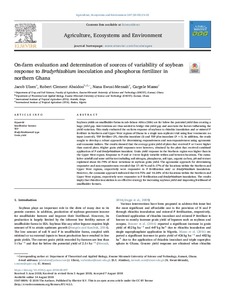| dc.contributor.author | Ulzen, J. |
| dc.contributor.author | Abaidoo, R.C. |
| dc.contributor.author | Ewusi-Mensah, N. |
| dc.contributor.author | Masso, C. |
| dc.date.accessioned | 2019-12-04T11:27:28Z |
| dc.date.available | 2019-12-04T11:27:28Z |
| dc.date.issued | 2018-11-15 |
| dc.identifier.citation | Ulzen, J., Abaidoo, R.C., Ewusi-Mensah, N. & Masso, C. (2018). On-farm evaluation and determination of sources of variability of soybean response to Bradyrhizobium inoculation and phosphorus fertilizer in northern Ghana. Agriculture, Ecosystems & Environment, 267, 23-32. |
| dc.identifier.issn | 0167-8809 |
| dc.identifier.uri | https://hdl.handle.net/20.500.12478/4941 |
| dc.description | Open Access Article; Published online: 14 Aug 2018. |
| dc.description.abstract | Soybean yields on smallholder farms in sub-Sahara Africa (SSA) are far below the potential yield thus creating a huge yield gap. Interventions are thus needed to bridge this yield gap and ascertain the factors influencing the yield variation. This study evaluated the on farm response of soybean to rhizobia inoculation and or mineral P fertilizer in Northern and Upper West regions of Ghana in a single non-replicate trial using four treatments: no input (control), TSP fertilizer (P), rhizobia inoculant (I) and TSP plus inoculant (P + I). In addition, the study sought to develop a robust approach for determining responsiveness and non-responsiveness using agronomic and economic indices. The results showed that the average grain yield of plots that received P or I were higher than control plots. Higher grain yield responses were however, obtained by the plots that received combined application of P and Bradyrhizobium inoculant. Grain yield response in the Northern region was higher than in the Upper West region. Response to P and or I were highly variable within and between locations. The cumulative rainfall and some soil factors including soil nitrogen, phosphorus, soil type, organic carbon, pH and texture explained about 42–79% of these variations in soybean grain yield. The agronomic approach for determining responsive and non-responsiveness revealed that 17–40 % and 6–17% of the locations within the Northern and Upper West regions, respectively were responsive to P fertilization and/ or Bradyrhizobium inoculation. However, the economic approach indicated that 64–75% and 14–24% of the locations within the Northern and Upper West regions, respectively were responsive to P fertilization and Bradyrhizobium inoculation. The results imply that rhizobia inoculation is an effective strategy for increasing soybean yield and improving livelihood of smallholder farmers. |
| dc.description.sponsorship | Bill & Melinda Gates Foundation |
| dc.format.extent | 23-32 |
| dc.language.iso | en |
| dc.rights | CC-BY-4.0 |
| dc.subject | Smallholders |
| dc.subject | Farmers |
| dc.subject | Bradyrhiobium |
| dc.subject | Soil Types |
| dc.subject | Soybeans |
| dc.subject | Grain Legumes |
| dc.subject | Yields |
| dc.subject | Ghana |
| dc.subject | West Africa |
| dc.title | On-farm evaluation and determination of sources of variability of soybean response to Bradyrhizobium inoculation and phosphorus fertilizer in northern Ghana |
| dc.type | Journal Article |
| dc.description.version | Peer Review |
| cg.contributor.crp | Grain Legumes and Dryland Cereals |
| cg.contributor.affiliation | Kwame Nkrumah University of Science and Technology |
| cg.contributor.affiliation | International Institute of Tropical Agriculture |
| cg.coverage.region | Africa |
| cg.coverage.region | West Africa |
| cg.coverage.country | Ghana |
| cg.creator.identifier | Robert Abaidoo: 0000-0002-1235-2252 |
| cg.creator.identifier | Cargele Masso: 0000-0002-3980-6832 |
| cg.researchtheme | NATURAL RESOURCE MANAGEMENT |
| cg.isijournal | ISI Journal |
| cg.authorship.types | CGIAR and developing country institute |
| cg.iitasubject | Grain Legumes |
| cg.iitasubject | Natural Resource Management |
| cg.iitasubject | Soybean |
| cg.journal | Agriculture, Ecosystems & Environment |
| cg.howpublished | Formally Published |
| cg.accessibilitystatus | Open Access |
| local.dspaceid | 101953 |
| cg.targetaudience | Scientists |
| cg.identifier.doi | https://doi.org/10.1016/j.agee.2018.08.007 |

